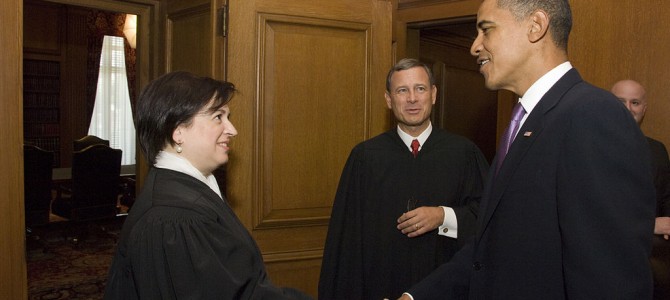
On Tuesday, the Supreme Court heard oral argument in Evenwel v. Abbott, the “one-person, one-vote” case that will decide whether state legislative districts should be drawn to equalize people or voters.
Texas claims it’s free to draw districts with the sole aim of making total populations equal, even if there are great disparities in the number of voters—and therefore the weight of each vote—from district to district. The plaintiffs argued that the only way to give people equal votes, as required by the Fourteenth Amendment’s Equal Protection Clause, is to put them in districts with equal numbers of voters.
Midway through the argument, Justice Elena Kagan brought forth seemingly damning evidence from the congressional debates over the Fourteenth Amendment—specifically its lesser-known second section, which apportions U.S. House members among the states according to their total populations (except untaxed Indians, and reduced by the number of 21-year-old males unlawfully disenfranchised—a protection for freedmen and Union sympathizers in the South):
JUSTICE KAGAN: The framers of the Fourteenth Amendment explicitly considered this issue, and, you know, made a decision. So Senator [Jacob] Howard [R-MI], who introduces the Amendment on behalf of the joint committee that drafts it, talks about these deliberations. And he says the committee adopted numbers as the most just and satisfactory basis, and that’s the principle upon which the Constitution itself was originally framed, referring back to the original drafting. And then he says numbers, not voters; numbers, not property; this is the theory of the Constitution. . . . This is just a clear, explicit choice that was made about what it meant to have equal representation with respect to [House apportionment]. And how you go from that being mandated to it being prohibited in the State context is something that I still can’t quite work myself around. (Transcript at 18-19.)
It seems like a compelling argument. Shouldn’t the selection of a total-population rule at the federal level indicate that the Fourteenth Amendment’s framers believed this was the true principle of democracy? What Kagan left out, however, is the beginning of Howard’s statement, which hints at a much less principled and more political story behind the total-population rule for apportionment.
SEN. HOWARD: Nor did the committee adopt the principle of making the ratio of representation depend upon the number of voters, for it so happens that there is an unequal distribution of voters in the several States, the old States having proportionally fewer than the new States. It was desirable to avoid this inequality in fixing the basis. The committee adopted [total] numbers as the most just and satisfactory basis, and this is the principle upon which the Constitution itself was originally framed, that the basis of representation should depend upon numbers; and such, I think, after all, is the safest and most secure principle upon which the Government can rest. Numbers, not voters; numbers, not property; this is the theory of the Constitution. (Emphasis added.)
The “inequality in fixing the basis” that Howard was referring to stemmed from a uniquely nineteenth-century problem: women were ineligible to vote, and as Sen. Luke Poland (R-Vermont) remarked, “The Union contains many very recently settled [western] States. . . . These new States to a great extent are settled by emigration from the older States, and it has been and will ever continue [to be] the case that a much larger proportion of this emigration are males. The consequence is that the newly settled States contain a very much larger proportion of males than the older States, and therefore a much larger ratio of voters.”
The West Was Voter-Heavy
Rep. James Blaine (R-Maine) was the first to discover this disparity. He warned that state eligible-voter populations ranged from a low of 19 percent in the East to a high of 58 percent in the West, so western states would gain vast relative power from a move to voter-based apportionment. As Sen. John Henderson (R-Missouri) later explained, it was the fear of this prospect among eastern members of Congress that defeated voter-based apportionment:
SEN. HENDERSON: At an early period of the session the prevailing sentiment . . . was in favor of a simple constitutional provision by which representation should be based on voters qualified as electors under the respective State constitutions and laws . . . . Just at this moment . . . [Rep. Blaine] betook himself to the census, and found the proposition would not do. It suddenly became unjust. Why unjust? Because, if adopted, the eastern and Atlantic states would lose power comparatively with the West. . . . It might drive the North and the East to woman suffrage, for which they were not prepared. The very moment Mr. Blaine made some figures on this subject and laid them before the House of Representatives, that proposition was dead forever. . . . The proposition died so soon as it was found that the East was to lose by it.” (Emphasis added.)
This description matches precisely the explanation Howard gave. Although he went on—in the only part of his speech Justice Kagan referenced—to frame the total-population rule as a matter of principle, he was more honest when he admitted that it was about allocating power between the “old States” and the “new States.”
Howard himself may have believed that it was “desirable” to avoid this power shift—many of the amendment’s framers sincerely believed husbands “virtually represented” their wives—but eastern opposition to the voter-based rule made its passage impossible and its retraction by the drafting committee was inevitable regardless of its members’ views regarding theories of representation.
As it turns out, then, Justice Kagan did not need to look very far at all for a clue toward how to “work herself around” to the possibility that the framers of the Fourteenth Amendment didn’t mean apportionment by total population to stand as an enduring principle of democracy in all circumstances. Had she looked two sentences earlier in the record, she would’ve seen that analogizing state districting to House apportionment is no more appropriate than the “federal analogy” to Senate apportionment that the Supreme Court rejected more than a half-century ago when it established the “one-person, one-person” principle.








